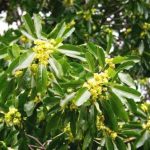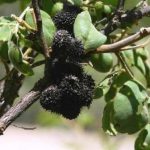TREE LIFE
May 2005
ANNUAL SUBS ARE DUE AGAIN. Prompt payment would be greatly appreciated.
MASHONALAND CALENDAR
Saturday 7th May Botanic Garden Walk. Continuing with the topic “Celastraceae” – the interesting and sometimes difficult family which contains several genera with which we are familiar such as Maytenus, Catha, Pleurostylia and some that we do not easily recognise such as Pterocelastrus, Cassine, and Hippocratea. Meet Tom in the car park at 10.45 for 11.00 a.m.
Sunday 15th May. The 55th Annual General Meeting will take place at Mr Moxom’s 64 acre property in Borrowdale.
Bring your lunch and a chair and please also bring a plate of eats to share for tea. Tea and coffee will be served at 9.30 and the meeting will start at 10. After the meeting we will have our usual botanical walk.
Saturday 28th May. Back to the Greystone Nature Reserve for Mark’s Walk, meeting in the car park at 2.30 p.m.
Saturday 4th June. Botanic Garden Walk.
MATABELELAND CALENDAR.
Please phone Gill Short for details of the next Matabeleland function.
CHAIRMAN’S REPORT TO THE A.G.M. ON MAY 15th 2005
I have pleasure in presenting the Chairman’s report for the year since the last A.G.M. on May 9th 2004.
General
As anticipated in my 2004 report, the year 2005 continued with the general themes of the previous 2 years, namely high inflation, low interest rates (at least on what we could earn), fuel shortages, constant emigration and problems with venues.
Postal charges, in particular, soared to unbelievable levels.
However, despite all of this, I felt that the year was slightly encouraging with a slightly more secure financial footing and with increasing membership at our outings.
Outings
During the year, a full complement of main 3rd Sunday outings was held, as shown in the following table:
Month Location
April 2004 Mazvikadei
May Thetford Estate
June Darwendale
July Pleasant Valley, Arcturus
August Christon Bank
September Chikupo Cave, Masembura CL
October Maringambizi
November Henry Hallam Dam
December (Xmas Social) Botanic Gardens
January 2005 Domboshawa
February Thetford
March Mukuvisi Woodland (Blatherwick Ave)
Longer trips were held to the Nyanga area in February and to Besna Kobila in March.
These have all been written up in Tree Life, so I will not discuss them again here. I am most grateful to all the landowners who gave us permission to visit and to all our stalwart leaders of the outings.
In particular, I am very grateful to Rob Burrett for leading beginners’ groups at our main outings. This has proved very popular with our members.
Once again, Tom Muller each month gave us his time to lead us in the Harare Botanic gardens. Subjects covered included the jesse, plants of termite mounds, climbers, the genera Rhus and Strychnos and the family Celastraceae.
Equally unstinting in her assistance to the Society was Meg Coates-Palgrave who again stood in for Tom while he was on holiday (Meg discussed miombo woodland and “Flowers and fruits”) and also led our main outing in the Mukuvisi Woodland in March 2005.
A nearly complete set of 4th Saturday walks was led by me near Harare. As usual, the herbaceous flora was given serious attention as also were weeds and even, from time to time, trees!
Other functions
The Committee gave a small farewell lunch to Vida Siebert in recognition of her many years on the Committee of the Society. Vida has gone to the UK and we wish her well for the future.
Matabeleland branch
During the year, attempts were made by J.P. Felu to resuscitate the branch and we thank him for his efforts.
Membership
The current membership, compared to previous years, is as follows:
MEMBERSHIP 2005 2004 2003 2002 2000 1999
Ordinary Members 167 159 158 188 218 201
Associate Members 5 5 7 14 14 14
Honorary Members 4 6 8 9 8 8
TOTAL 176 170 173 211 240 223
It may be seen that although the membership has increased slightly, we have not returned to the pre-2002 levels.
I would like to thank Linda for continually keeping the Twinarts emails up to date. This has continued to be a great source of new members.
We report with sadness the death of 8 members (or former members) during the year, namely: John Cottrill, Trevor Gordon, Maurice Graves, Derek Henderson, Joy Killian, Des Lovemore, Eden Simon and Duncan Torrance.
Trevor Gordon was an enormously important and influential member of the Society for many years. Joy Killian was also, for many years, the Treasurer of the Society.
During the year, Andy MacNaughtan, our previous past Chairman for 8 years, finally succeeded in emigrating to Australia. We wish him well for the future.
Another sad loss to the Society was Jonathan Timberlake, who left in April to take up a post at the Royal Botanic Gardens, Kew. Apart from his work on the Matabeleland Branch, Jonathan has been a source of advice and of information from the wider world for many years. He will be very much missed.
Tree Mapping
The Tree Mapping data is being updated periodically by Maureen.
Tree Life
Perhaps the major effort of the Society is the production of our monthly Newsletter. Most of the hard work falls on Maureen and I am very grateful to her for her hard work. John Lawrence has been of great assistance in writing up our outings.
Tree Life is also our major cost and determined efforts have been made in reducing the number of printed and posted copies. This is slowly paying off.
Finance
The year under review was generally a bit easier financially. However, we have recently heard that GP2, the organization holding our money, has had its licence cancelled by the authorities. Although we understand that our money is safe, it is at present not accessible by the Society.
Terry Fallon has continued his hard work as Treasurer and we are very grateful to him.
Publications
Lyn Mullin’s book Historic Trees of Zimbabwe has continued to sell well. Copies are still available via Maureen.
The Mweb web site has been maintained on a regular basis by Odette Lind and we are very grateful to both Odette and Mweb for their support.
Finally,
I would, once again, like to thank the Committee for their hard work and support during the past year.
-Mark Hyde, Chairman
MUKUVISI WOODLAND: 20 MARCH 2005
36 members gathered inside the Blatherwick Avenue entrance of the Mukuvisi Woodland on Sunday 20th March. One of the purposes of this outing, which was organised jointly with the Wildlife Society, was to attract new members and to collect subscriptions for the new year from existing members. We had an excellent turnout and the idea proved to be quite successful in that we acquired 2 new members and collected over $700,000 in subscriptions.
The first part of the morning was taken up with these non-botanical administrative matters, but at 10 a.m. we split into three groups, led respectively by Meg Coates Palgrave, Rob Burrett and myself. My group crossed the Mukuvisi by the footbridge and walked downstream on the northern bank. The vegetation was basically sandy miombo woodland together with the riverine vegetation by the Mukuvisi.
Recently (i.e. within the last few years) this part of the woodlands has been sealed off from the public by a fence. No longer are there people living in shacks by the river and this, to some extent, has allowed the vegetation to recover a bit. And it is a very interesting area, too, although more for the herbaceous vegetation perhaps than the trees.
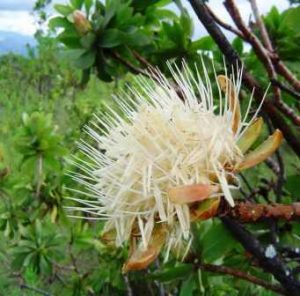
Protea welwitschii. Photo: Bart Wursten. Source: Flora of Zimbabwe
One of the trees seen was Protea welwitschii, the Honey-scented protea. This is one of three common species of Protea that occur around Harare, and indeed in the Mukuvisi woodland, and it can be readily distinguished from the other two (P. gaguedi and P. angolensis) by having leaves that are brown-hairy, or, in Tree Society parlance, “welwitty”. The other two species are hairless.
Lannea discolor (Livelong) must be one of the commonest trees and is certainly one that we see a lot of on our outings. The leaves are compound, actually pinnate, and bear a terminal leaflet; i.e. they are imparipinnate. The most noticeable feature of the leaves is that they are discolorous, with a green colour above and whitish beneath, and this of course is the derivation of the specific name.
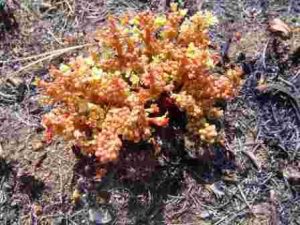
Lannea edulis. Photo: Bart Wursten. Source: Flora of Zimbabwe
Nearby was the small plant Lannea edulis, another member of the same genus. Unlike L. discolor, which is a tree, L. edulis is a suffrutex with annual stems arising from an underground woody rhizome. Just as at Thetford the month before were we saw numerous suffrutices, we did so again here, showing how much a feature of miombo woodland they are.
Once such suffrutex was Grewia decemovulata. Apart from its small size, it can be separated from other grewias by its green leaves, which are not white beneath, and by the symmetric leaf base. As at Thetford, we also saw the Makoni tea bush, Fadogia ancylantha and another herb whose leaves are used to make tea, Lippia javanica.
By the river, we saw the Waterberry, Syzygium cordatum. This has square branchlets and more or less stalkless leaves that clasp the stem slightly. The leaves are also opposite and decussate and quite densely arranged along the stem. This tree likes to have its feet more or less in the water – one way to distinguish it from its drier woodland counterparts.
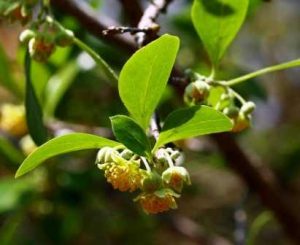
Dovyalis zeyheri. Photo: Bart Wursten. Source: Flora of Zimbabwe
Also by the river was Dovyalis zeyheri, (Oval kei-apple) the glossy leaves of which caught our attention, and Celtis africana (the White stinkwood). At the water’s edge were naturalised cedrelas (Toona ciliata) with its huge 1-pinnate leaves.
One feature of this area is the unexpected presence of exotic plants, some looking very well naturalised indeed or maybe simply being long-established relics of cultivation. On our morning walk we suddenly came across a fine colony of the White poinsettia, Euphorbia leucocephala.
On the afternoon walk, on the other side of the river, there is a fine bamboo. I have seen it before and believe that it is Bambusa vulgaris. It is one of the ones commonly planted around Harare with tall culms that are striped orange and green. Whatever its origin, it now merges perfectly into the native vegetation, although I suspect that it was originally planted.
By now, lunch was calling and we headed back to a shady spot near to where we had parked the cars and ate our lunch.
The afternoon saw a very small group of us walk down the other side of the river. Nothing very remarkable was seen, but it was a nice habitat and a pleasant walk. Apart from the bamboo mentioned above, I did manage to photograph a common fern, Arthropteris orientalis which is abundant in shady places amongst rocks.
Our great thanks go to Meg for being our guest leader for the day and also to Rob for his help as well. Also to Irene Sharp for making the arrangements from the Wildlife Society end.
-Mark Hyde
Tree Society Visit to Besna Kobila
To my horror I was designated, with no recourse to appeal, to write up the Tree Society visit to Besna Kobila over the Easter weekend! This property is part of the Dwala Conservancy situated in the magnificent Matobo Hills, which were declared a World Heritage Site in July, 2003. “Dwala” is the Ndebele word for the smooth granite whaleback hills that characterise the Matopos and is also the name of the camp we stayed at, which consists of comfortable refurbished stables with all mod cons. The estate, which is owned and managed by the Stephens family, has rivers, dams, kopjes and vleis and is an important water catchment and storage area as it occupies some of the highest ground in Matabeleland and therefore has a large variety of plants, including about 20 species of wild orchid. There is also a variety of wildlife including zebra, impala and klipspringer and 68 species of birds were seen.
We had been camping at Hwange and went straight to Besna Kobila from there, arriving late on Thursday evening. We were joined later the following day by Jonathan Timberlake, who told us that unfortunately no-one else from Harare would be coming after all. Later in the afternoon that irrepressible story-teller Myles Standish-White and his wife Margaret arrived from Chinhoyi. Joan and Roy Stephens, Jenny Timberlake and their two children Tom and Frances, Drew Coneybear and Margie Pearce made up the Matabeleland contingent.
The area is truly impressive with its jumble of rocks of all shapes and sizes, plants of different shades of green, orange and grey lichens and wild flowers of all colours. We enjoyed several walks with spectacular views and spent one evening at the top of a dwala with the sunset on one side and the rising full moon on the other – both huge orange balls. We were shown a cave, with the remains of ancient grain bins, which extends for about 100 metres to exit on the other side of the dwala, but which would entail crawling on one’s stomach – definitely not for those with a fuller figure or claustrophobia!
All in all a very enjoyable few days and definitely a place to visit again. Thanks to the Stephens and Jonathan whose knowledge was invaluable. Our best wishes to Jonathan and his family who are shortly off to England – yet another loss for Zimbabwe.
And for those who are wondering what trees and shrubs we did see – the list follows!
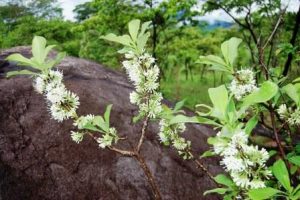
Pavetta schumanniana. Photo: Stefaan Dondeyne. Source: Flora of Zimbabwe
Acacia sieberiana (although galpinii, karroo, nigrescens and rehmanniana are also found there), Acokanthera rotundata, Adansonia digitata, Afzelia quanzensis, Albizia amara, antunesiana and tanganyicensis, Aloe excelsa, Annona stenophylla, Antidesma venosum, Apodytes dimidiata, Barleria albostellata, Boscia albitrunca, Brachylaena rotundata, Bridelia mollis, Burkea africana, Canthium lactescens, Cassia abbreviata, Catha edulis, Chionanthus battiscombei, Clerodendrum myricoides, Combretum molle, Commiphora marlothii and mollis, Croton gratissimus, Cussonia arborea, natalensis and spicata, Dichrostachys cinerea, Dombeya rotundifolia, Dovyalis zeyheri, Elephantorrhiza burkei, Erythrina latissima and lysistemon, Erythroxylum emarginatum, Euclea natalensis and racemosa, Euphorbia cooperi, griseola and matabelensis, Faurea saligna, Ficus glumosa, natalensis, sur and verruculosa, Flacourtia indica, Grewia monticola, Halleria lucida, Heteropyxis dehniae, Kirkia acuminata, Lannea discolor, Maytenus heterophyllla and senegalensis, Mimusops zeyheri, Mundulea sericea, Nuxia oppositifolia, Olax dissitiflora, Olea europea subsp. africana, Olinia vangueriodes, Ozoroa insignis, Pappea capensis, Parinari curatellifolia, Pavetta schumanniana, Peltophorum africanum, Pittosporum viridiflorum, Pouzolzia mixta, Protea gaguedi, Pseudolachnostylis maprouneifolia, Ptaeroxylon obliquum, Pterocarpus angolensis and rotundifolius, Rhoicissus tridentata, Rhus leptodictya, Schrebera alata, Sclerocarya birrea, Sesbania sesban, Strychnos madagascariensis, matopensis and spinosa, Tarenna zimbabwensis, Terminalia brachystemma and sericea, Trema orientalis, Turrea nilotica, Vepris reflexa, Zanthoxylum capense, Ziziphus mucronata.
-Carolyn Dennison
EASTER MONDAY 28TH MARCH 2005 –BESNA KOBILA, MATOPOS
We awoke to a beautiful morning and found we had had 15 mm of much-needed rain in the night. The sun was just coming through the great Parinari trees that surround this enchanting camp and every bird in the place was singing his head off, particularly the Natal Francolin, with their smart yellow legs, as they darted about picking up last night’s termite alates.
After breakfast, we found our party of explorers somewhat depleted, but our sweet and indomitable hostess, Joan, lead five of us first southwards, on the level, past well-watered vleis, into their other property, Shumba Shaba.
The hungry granite sandveld sports a cover of predominantly Pterocarpus rotundifolius and Acacia sieberiana, Schrebera trichoclada and various Strychnos spp., plus an assortment of Hyparrhenia (sp.?) grasses.
We turned east, past one of the lodges, all of which have been vandalized to some extent and worked our way down one of the several watercourses, which drain the rich sponges, down the escarpment into the Mtchabezi Valley, where there is a big dam. Joan pointed out some noble Brachystegia glaucescens, whose colours are fantastic in the spring and some Heteropyxis dehniae next to the stream, reminding me of old Gertrude Dehn, whom we used to know very well. She wrote a botanical book in Latin, which not many people can have done, and also her husband, an upper-crust Bavarian, had Adolph Hitler as his batman in WW1! Said he was a grumpy, moody man, but he did get an Iron Cross, 2nd class, which is quite difficult to do as a corporal.
On the way down, Joan showed us some dozen or so old native grain bins, very skillfully hidden in a cave, the entrance to which was almost invisible, covered by a cracked-off piece of granite. These were probably built by the Kalanga people, who were forced into the hills by successive wars of Nguni invaders from the South, themselves fleeing from Tchaka the Zulu. First we had the Angoni, who were of Swazi origin, then the Shangaans and finally the Matabele in about 1838. All these warriors regarded the locals with the utmost contempt and killed them on sight.
Joan led us across a ridge, heading northwards into another valley, and then westwards up a stream, the headwaters of which we explored yesterday.
Young Tom plunged into the swimming pool, whilst the rest of us marvelled at the change the rain had made in just one day. Resurrection bushes, Myrothamnus flabellifolius, like biltong yesterday, looked like vivid green bonsai oak trees. I had never seen them over a metre tall before.
So our wonderful stay at Besna Kobila came to an end. Apart from a fantastic assortment of vegetation, we saw Black Eagles, White-necked Ravens, Lanner Falcons and other rare birds. I was a bit sad not to see one single dassie, because as kids in the 1940’s we were accustomed to seeing masses of them in the Matopos. Joan Stephens was the most wonderful hostess, and we wish them luck in their valiant struggle to preserve this unique area for future generations, having the terrifying tsunami of over-population right against the fence.
-Miles Standish-White
HISTORIC TREES OF ZIMBABWE By LYN MULLIN
Copies of this wonderful book are still available from Maureen Silva-Jones.
Telephone. Home 740479; Work 757171 (Harare)
Prices: Soft Cover – $90 000 back in stock.
Hard Cover – $150 000
Leather Bound – $200 000
The Petheram Files Continued
The ‘Press Tree’
In the grounds of Government House (today’s State House) in Harare there used to be a huge and impressive Belhambra (Phytolacca dioica), which was named the ‘Press Tree’ because it was the only piece of ground within the boundaries of Government House where members of the Press were officially allowed to tread. It had reached a girth of 8 metres and a height of 15-18 metres by the time it collapsed in September 1978. No one knows when it was planted, or by whom, but it had probably seen every occupant of Government House—Governor, Governor-General, or President—down to the time of John Wrathall.
Wooden Dentures
The first-ever set of false teeth was made from the wood of the elm (Ulmus sp.), and was worn by no less a personage than George Washington (1732-1799), first President of the United States of America.
-Lyn Mullin To be continued
MARK HYDE CHAIRMAN


